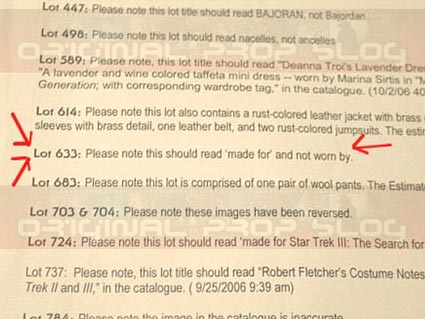Two years after making the rounds as a lead story in the mainstream media, the Associated Press today reports that the Supreme Court of New York’s Appellate Division ruled that a Star Trek fan does not deserve $7 million dollars in damages as a result being displeased with one of the three items won at the “40 Years of Star Trek” auction held by Christie’s. The buyer claimed that one of the original props – a poker visor attributed to Brent Spiner’s “Data” character in the Star Trek: The Next Generation television series – was not the one seen on screen in the final episode.
The Plaintiff, Ted Moustakis of New Jersey, claimed that he met Brent Spiner at a Star Trek convention and that the actor told him it was not the one he wore in the famous final scene of the series.
Moustakis won three items at auction – a poker visor for $6,600, a poker table for $11,400, and a uniform for $6,000. Based on his claim that one was misrepresented, he sought $7 million dollars in damages.
The Original Prop Blog covered this story in detail in December 2007 and January 2008, and full coverage of this story can be found in the series of articles (Auction Houses and Prop Dealers | Christie’s | Christie’s ‘Star Trek’ Lawsuit):
As explained in the articles two years ago, I recalled and had notes from the time of my recollection of the Christie’s auctioneer announcing an amendment to the Data poker visor before opening the lot for bids – that it was not worn on screen (at odds with the basis of the lawsuit) – as that was one of the few items I asked a friend of mine who was present at the event to place a bid for on my behalf.
I had posted a scan of the official Christie’s lot/description amendment sheet pertaining to the visor made available to live bidders at the event (the plaintiff, Moustakis, was also present at the event), which added a note to the description of the visor in question: “Please note this should read ‘made for’ and not worn by“:
Link to Full Amendment courtesy Jason White: LINK
The quotes attributed to the plaintiff and attorney in the mainstream media coverage in late 2007 did not account for the Christie’s lot/description amendment above, nor any relevant comments made by the auctioneer (which was broadcast in real time for remote bidders at the time of the auction).
Below is the decision as published on the New York State Unified Court System Website:
Moustakis v Christie’s, Inc.
2009 NY Slip Op 09543
Decided on December 22, 2009
Appellate Division, First Department
Published by New York State Law Reporting Bureau pursuant to Judiciary Law § 431.
This opinion is uncorrected and subject to revision before publication in the Official Reports.
Decided on December 22, 2009
Sweeny, J.P., Catterson, Renwick, Freedman, Abdus-Salaam, JJ.
1847 117179/07
[*1]Ted Moustakis, Plaintiff-Appellant,
v
Christie’s, Inc., et al., Defendants-Respondents.
Jeffrey Benjamin, P.C., Forest Hills (Jeffrey Benjamin of counsel), for appellant.
Levine Sullivan Koch & Schulz, L.L.P., New York (Nicole A. Auerbach of counsel), for respondents.
Order, Supreme Court, New York County (Joan A. Madden, J.), entered October 7, 2008, which granted defendants’ motion to dismiss the complaint to the extent of dismissing all causes of action related to one of the items purchased by plaintiff, as well as the claims for fraud, negligent misrepresentation and violation of the General Business Law relating to all items, and the demands for punitive damages, unanimously affirmed, without costs.
This action arises out of an auction of memorabilia from the Star Trek television series and motion pictures. Contrary to plaintiff’s contention that defendant Christie’s had represented the Commander Data uniform to be one of a kind, no such representation was ever made in the auction catalogue. Significantly, the Conditions of Sale, which plaintiff accepted in order to be allowed to participate in the bidding process, expressly declared that “all property is sold as is’ without any representation or warranty of any kind by Christie’s or the seller.” UCC 2-316(3)(a) recognizes that “unless the circumstances indicate otherwise, all implied warranties are excluded by expressions like as is’ . . . which in common understanding calls the buyer’s attention to the exclusion of warranties and makes plain that there is no implied warranty.”
Even assuming there was a breach of contract or warranty as to the other two items purchased by plaintiff at the auction, he was, under the Conditions of Sale, contractually precluded from pursuing the massive recovery he now demands. The only remedy available to him thereunder would be a refund of the sale price(s) upon return of the item(s), a limitation generally permissible in contracts for the sale of goods (see UCC 2-719[1][a]).
The allegations of fraud and negligent misrepresentation are virtually identical to those upon which the causes of action for breach of contract and breach of warranty rest, and are thus duplicative, inasmuch as there is no pleading of the breach of a duty separate and apart from the contractual obligation owed to plaintiff. In that regard, it is axiomatic that “a simple breach of contract is not to be considered a tort unless a legal duty independent of the contract itself has been violated” (Clark-Fitzpatrick, Inc. v Long Is. R.R. Co., 70 NY2d 382, 389 [1987]).
Nor does plaintiff have a viable cause of action against these defendants under General Business Law § 349 or § 350. A party seeking those remedies must charge conduct that is consumer oriented, with an impact on the public at large (Canario v Gunn, 300 AD2d 332 [*2][2002]). Finally, the misconduct alleged here, which arises from a private contract, does not resemble the egregious wrongdoing that could be considered part of a pattern directed at the public generally, so as to warrant the imposition of punitive damages (see Garrity v Lyle Stuart, Inc., 40 NY2d 354, 358 [1976]).
THIS CONSTITUTES THE DECISION AND ORDER
OF THE SUPREME COURT, APPELLATE DIVISION, FIRST DEPARTMENT.
ENTERED: DECEMBER 22, 2009
CLERK
As I stated two years ago, I do have sympathy for any collector who feels that what he or she purchased did not meet expectations, especially with regards to any issues of authenticity. However, I do not see how that amounts to a refund plus $7 million dollars in damages, so I am pleased to see how the court has ruled in this case.
For a legal perspective, visit Law.com:
Jason De Bord



